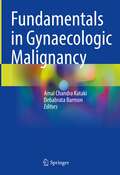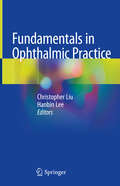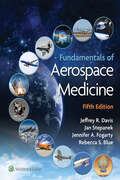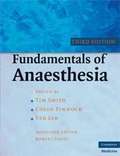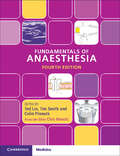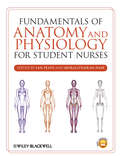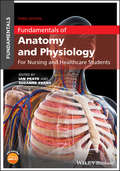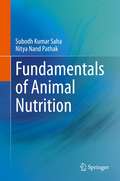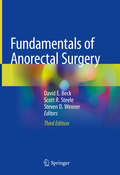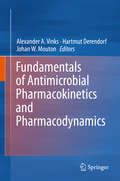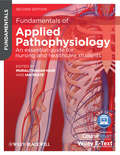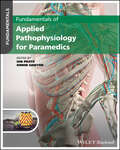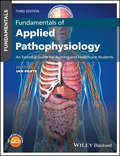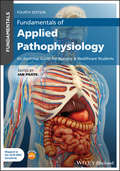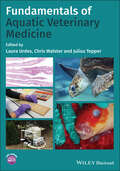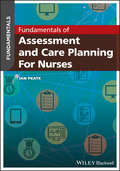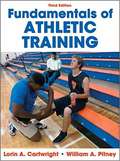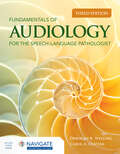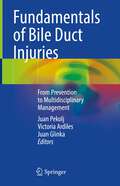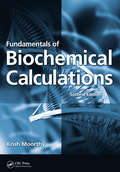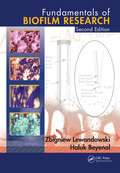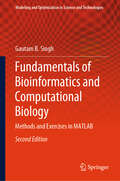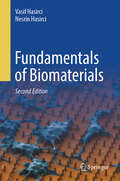- Table View
- List View
Fundamentals in Gynaecologic Malignancy
by Amal Chandra Kataki Debabrata BarmonThis book is a complete representation of all the gynecological cancers covering from the anatomical details of the individual gynecological organs along with the epidemiological pathophysiological aspects of the various gynecological cancers. It also covers the diagnostic workup of various gynecological cancers with recent evidence based treatment protocols. All the major gynecological oncological surgeries are described in a simple way along with photographs for easy understanding in all the chapters. In addition, numerous flowcharts and management algorithms are included in every chapters, as a ready reference for the benefits of the trainees and practitioners. This book includes chapters such as critical care in oncology, oncology nursing, benign and malignant breast disease, hormones and gynecological cancer, cancer infections and vaccines, palliative care which are not often found in many text books. Apart from these, this book has also included chapters like principles and practice of Radiation oncology, surgical oncology and medical oncology, recent advances and imaging in gynecological malignancy to make it a complete package. Thus, it will serve as an excellent reference book for surgical oncologists, general gynecologists, medical and radiation oncologists fellows and trainees.
Fundamentals in Ophthalmic Practice
by Christopher Liu Hanbin LeeThis book provides an expert overview of all aspects of ophthalmic care in clinical practice. Areas such as External eye, Cornea and conjunctiva, Glaucoma, Cataract, Macular degeneration and Diabetic retinopathy and retinal vascular events are discussed throughout the chapters. Essentials in Ophthalmic Practice will be a go-to guide for ophthalmologists, optometrists, orthoptists, ophthalmic nurses, ophthalmic technicians and other allied health professionals in their busy day-to-day practice.
Fundamentals of Aerospace Medicine
by Jeffrey Davis Jan Stepanak Jennifer Fogarty Rebecca BlueEncompassing all occupants of aircraft and spacecraft—passengers and crew, military and civilian—Fundamentals of Aerospace Medicine, 5th Edition, addresses all medical and public health issues involved in this unique medical specialty. Comprehensive coverage includes everything from human physiology under flight conditions to the impact of the aviation industry on public health, from an increasingly mobile global populace to numerous clinical specialty considerations, including a variety of common diseases and risks emanating from the aerospace environment. This text is an invaluable reference for all students and practitioners who engage in aeromedical clinical practice, engineering, education, research, mission planning, population health, and operational support.
Fundamentals of Anaesthesia
by Robert Jones Tim Smith Colin Pinnock Ted LinThe third edition of Fundamentals of Anaesthesia is the gold standard text for the Primary FRCA, encapsulating the basic principles of modern anaesthesia in one easily accessible volume. Written and edited by a team of expert contributors with extensive FRCA examination experience, Fundamentals of Anaesthesia, Third Edition deliberately blends the expertise of invited authors in an unrivalled consistency of style more akin to that of a single author text. Deliberate use of authors with a more general anaesthesia background ties in well with the education of anaesthetists in their early years. The third edition is fully updated, with a number of completely new chapters. Presentation of information is clear and concise, with extensive use of tables, colour illustrations, summary boxes of key information and bullet lists. This Highly Commended award winning textbook is a unique revision aid for the Primary FRCA and an essential companion for all exam candidates.
Fundamentals of Anaesthesia
by Robert Jones Tim Smith Colin Pinnock Ted Lin Tim Smith Colin Pinnock Ted LinThe third edition of Fundamentals of Anaesthesia is the gold standard text for the Primary FRCA, encapsulating the basic principles of modern anaesthesia in one easily accessible volume. Written and edited by a team of expert contributors with extensive FRCA examination experience, Fundamentals of Anaesthesia, Third Edition deliberately blends the expertise of invited authors in an unrivalled consistency of style more akin to that of a single author text. Deliberate use of authors with a more general anaesthesia background ties in well with the education of anaesthetists in their early years. The third edition is fully updated, with a number of completely new chapters. Presentation of information is clear and concise, with extensive use of tables, colour illustrations, summary boxes of key information and bullet lists. This Highly Commended award winning textbook is a unique revision aid for the Primary FRCA and an essential companion for all exam candidates.
Fundamentals of Anaesthesia (Qbase Ser.)
by Tim Smith Colin Pinnock Ted Lin Chris MowattThe third edition of Fundamentals of Anaesthesia is the gold standard text for the Primary FRCA, encapsulating the basic principles of modern anaesthesia in one easily accessible volume. Written and edited by a team of expert contributors with extensive FRCA examination experience, Fundamentals of Anaesthesia, 3rd edition deliberately blends the expertise of invited authors in an unrivalled consistency of style more akin to that of a single author text. Deliberate use of authors with a more general anaesthesia background ties in well with the education of anaesthetists in their early years. The third edition is fully updated, with a number of completely new chapters. Presentation of information is clear and concise, with extensive use of tables, colour illustrations, summary boxes of key information and bullet lists. This Highly Commended award winning textbook is a unique revision aid for the Primary FRCA and an essential companion for all exam candidates.
Fundamentals of Anatomy and Physiology for Student Nurses
by Ian Peate Muralitharan NairThe mind and the body, when working in harmony, is a fantastic system capable of extraordinary things.With an applied, interactive, and highly visual approach, Fundamentals of Anatomy and Physiology for Student Nurses provides students with an exciting and straightforward understanding of anatomy and physiology, enabling them to deliver high quality care in any setting. This book covers the structure and functions of the human body, with clinical applications throughout.Key features:A clear, straightforward book on anatomy and physiology for all students in nursing and allied health.Fully interactive, with an activity section at the end of each chapter, featuring multiple choice questions, diagram labelling, test your learning questions, crosswords, and 'find out more'.Generous, full colour illustrations throughoutClinical considerations and scenarios throughout showing how the material can be applied to daily practiceA companion website where you'll find further exercises, illustrations, and interactive MCQs www.wiley.com/go/peate
Fundamentals of Anatomy and Physiology: For Nursing and Healthcare Students (Fundamentals)
by Suzanne Evans Ian PeateComprehensive, illustrated, and perhaps most importantly: applicable in practice. The latest edition of this best-selling textbook proves difficult to put down. The third edition of Fundamentals of Anatomy and Physiology is a concise yet comprehensive introduction to the structure and function of the human body. Written with the needs of nursing and healthcare students in mind, this bestselling textbook incorporates clinical examples and scenarios throughout to illustrate how the topics covered are applied in practice. Hundreds of full-colour illustrations complement numerous case studies encompassing all fields of nursing practice, alongside learning outcomes, self-assessment tests, chapter summaries, and other effective learning tools. This latest edition has been thoroughly updated by a team of international contributors to reflect the current Nursing and Midwifery Council (NMC) Standards for Education, with enhanced online learning resources including an image bank, a searchable online glossary, flashcards, interactive multiple-choice questions, and more. Offering a user-friendly introduction to anatomy and physiology, this textbook: Provides a variety of clinical scenarios and examples to relate theory to practice Outlines the disorders associated with each chapter’s topic Presents information on medicines management for each body system Is written by an international team Features extensive supplementary online resources for both students and instructors Is available with accompanying study guide, Fundamentals of Anatomy and Physiology Workbook Fundamentals of Anatomy and Physiology is the perfect introduction to the subject for student nurses, particularly those in the first year of their course, healthcare assistants and nursing associates, and other allied health students.
Fundamentals of Anatomy and Physiology: Study Guide (Fifth Edition)
by Charles M. SeigerFundamentals of Anatomy and Physiology: Study Guide (Fifth Edition)
Fundamentals of Animal Nutrition
by Subodh Kumar Saha Nitya Nand PathakThe book provides comprehensive information about the different aspects of veterinary nutrition in tropical countries.The introductory chapter discuss the importance of nutrition, feeds and feeding of balanced and optimum feeds specifically required for the sustenance of life. The second chapter, discusses briefly the history of research in animal nutrition.The book further talks about the relationship between the environment and nutrition in animals; the chemical composition of plants and animals; and the various sources of feed for animals. It provides details on the different phases of life cycle in animals, and the effect of nutrition on the performance. Various Nutrients and its importance in livestock nutritionand production has been illustrated in details. Various nutrients such as water, carbohydrate, protein, fats, vitamins, minerals etc are individually dealt in a separate chapter. The digestive system,digestion and metabolism of carbohydrates, protein and fats in ruminant and non ruminant livestock have been illustrated. A dedicated chapter fully describes the activity of enzymes which are directly involved in nutrition. Also this book deals with the harmful components of animal feed which are found mainly in the unconventional feeds. The books also provide chapters like partitioning of feed& energy and also the therapeutic and clinical nutrition which are very importantfor the under graduate & post graduate students and researchers of animal nutrition and livestock production and management. This book is useful for researchers, undergraduate and post graduate students studying veterinary sciences, animal husbandry, zoology and biochemistry.
Fundamentals of Anorectal Surgery
by David E. Beck Steven D. Wexner Scott R. SteeleThis book is a comprehensive and current guide to the diagnosis and treatment of the entire spectrum of anorectal diseases. It focuses mainly on anorectal problems, as anorectal pathology is often more complex and challenging for surgeons than colonic diseases.The book covers anorectal anatomy, physiology, and embryology as a foundation to a detailed description of preoperative, intraoperative, and post-operative patient management. All surgical procedures are shown in step-by-step detail by leading surgeons and gastroenterologists. This book will be relevant to general, colon, and rectal surgeons in training and practice, gastroenterologists, and other practitioners with an interest in anorectal diseases.
Fundamentals of Antimicrobial Pharmacokinetics and Pharmacodynamics
by Alexander A. Vinks Hartmut Derendorf Johan W. MoutonOver the past decade, significant progress has been made in the theory and applications of pharmacodynamics of antimicrobial agents. On the basis of pharmacokinetic-pharmacodynamic modeling concepts it has become possible to describe and predict the time course of antimicrobial effects under normal and pathophysiological conditions. The study of pharmacokinetic-pharmacodynamic relationships can be of considerable value in understanding drug action, defining optimal dosing regimens, and in making predictions under new or changing pre-clinical and clinical circumstances. Not surprisingly, pharmacokinetic-pharmacodynamic modeling concepts are increasingly applied in both basic and clinical research as well as in drug development. The book will be designed as a reference on the application of pharmacokinetic-pharmacodynamic principles for the optimization of antimicrobial therapy, namely pharmacotherapy, and infectious diseases. The reader will be introduced to various aspects of the fundamentals of antimicrobial pharmacodynamics, the integration of pharmacokinetics with pharmacodynamics for all major classes of antibiotics, and the translation of in vitro and animal model data to basic research and clinical situations in humans.
Fundamentals of Applied Pathophysiology
by Ian Peate Muralitharan NairFundamentals of Applied Pathophysiology is designed specifically for nursing and healthcare students, providing a straightforward, jargon-free, accessible introduction to pathophysiology. Highly visual and written specifically for students, the second edition of this best-selling textbook provides clear explanations of the anatomy of the human body, and the effects of disease or illness on normal physiology. To make study easier, the book includes learning outcomes, a range of activities to test learning, key words, end-of-chapter glossaries, and clinical case scenarios, and is supported by an online resource centre with further activities and exercises. Key Features:Superb full colour illustrations, bringing this subject to lifeFull of extra features to help improve the learning process, including key words, test-your-knowledge, exercises, further reading and learning outcomesNew case studies throughout to help you understand how to apply the knowledge in clinical practiceSupported by an online resource centre at www.wiley.com/go/fundamentalsofappliedpathophysiology with fantastic extras for both lecturers and students, including an image bank, interactive multiple choice questions, true/false exercises, word-searches, glossary flash-cards, label-the diagram activities, and more!
Fundamentals of Applied Pathophysiology for Paramedics (Fundamentals)
by Ian Peate Simon SawyerFundamentals of Applied Pathophysiology for Paramedics An essential introduction to pathophysiology for paramedics Paramedics are specialists in out-of-hospital emergency healthcare; they are also capable of operating as generalist clinicians whose work is indispensable in a variety of healthcare settings. The response to the COVID-19 pandemic, especially, has revealed the versatility of the paramedic workforce. Contemporary paramedic practice continues to break new ground as the workforce is called upon to undertake critical roles in support of the wider healthcare sector. However, to perform their crucial work paramedics require a strong understanding of pathophysiology to enable them to make rapid and effective clinical decisions. Fundamentals of Applied Pathophysiology for Paramedics is a comprehensive introduction to this subject for aspiring, early-career, and experienced paramedics. This textbook links theory to practice and supports high-quality care in dynamic, fast-paced environments. Drawing on the latest available evidence and clinical best practice, it promises to support current paramedics, and prepare student paramedics for their future as healthcare professionals. User-friendly organisation of topics broken down by body systems Detailed discussion of patient-focused issues, common and specialised diseases, and more Physiological and psychological alerts to aid in diagnosis and response Fundamentals of Applied Pathophysiology for Paramedics is ideal for all paramedic students and early career paramedics.
Fundamentals of Applied Pathophysiology: An Essential Guide for Nursing and Healthcare Students
by Ian PeateFundamentals of Applied Pathophysiology continues to be an accessible and comprehensive introductory text to pathophysiology, written specifically for nursing and healthcare students to assist in the understanding of human anatomy, and the complex disease patterns that affect normal physiology. Thoroughly updated, and with full-colour illustrations throughout, this new edition incorporates additional learning features including reflective questions at the end of each chapter, investigation boxes, medication alerts, red flags to indicate essential information to be aware of when providing care, vital signs boxes relating to physiological measurements as well as inclusion of the National Early Warning Score. With emphasis placed on a multidisciplinary approach, Fundamentals of Applied Pathophysiology highlights the importance of contemporary, safe, and effective practice in an environment in which the delivery of care is constantly evolving.
Fundamentals of Applied Pathophysiology: An Essential Guide for Nursing and Healthcare Students (Fundamentals)
by Ian PeateFundamentals of Applied Pathophysiology delivers a highly visual and accessible introduction to pathophysiology for nursing and healthcare students, guiding readers through the subject matter with case studies, exercises, key words, and additional resources to support learning and retention. The new edition of Fundamentals of Applied Pathophysiology includes brand-new content on homeostasis, systematic approach to assessment, and key terminology. The book features links to clinical observations, vital signs to observe, investigation boxes, clinical red flags, medication alerts, and the latest, contemporary evidence for care management, including National Early Warning Score 2 (NEWS2). Presents comprehensive treatment guidance for all fundamental pathophysiology categories, including disorders of the central nervous system, heart, vascular and renal systems, and more Aligns with the latest NMC standards Full-colour illustrations throughout that brings the subject to life Fundamentals of Applied Pathophysiology belongs on the bookshelves of all pre-registration nursing students, paramedic students, midwifery students, healthcare assistants, and assistant practitioners. Professionals in allied healthcare areas such as physiotherapy, radiotherapy, and occupational therapy will also benefit from the material contained in this comprehensive resource.
Fundamentals of Aquatic Veterinary Medicine
by Laura Urdes Chris Walster Julius TepperFundamentals of Aquatic Veterinary Medicine Covers the competencies necessary to assure the highest quality of aquatic veterinary services Fundamentals of Aquatic Veterinary Medicine provides systematic, highly practical guidance on the treatment of aquatic mammals, amphibians, fish, and invertebrates in veterinary practice. Mapping to each of the nine core areas of the WAVMA Certified Aquatic Veterinarian (CertAqV) Program, this comprehensive clinical reference covers taxonomy, anatomy and physiology of aquatic species, water quality and life support systems, diagnostics, treatment, and prevention of aquatic diseases, and more. Designed to help readers acquire and demonstrate the necessary knowledge, skills, and experience to be competent in aquatic veterinary medicine, this authoritative guide: Focuses on "Day One" competencies outlined by the World Organization for Animal Health (OIE) Covers pathobiology and epidemiology of aquatic diseases, public health, zoonotic diseases, and seafood safety Provides up-to-date information on relevant legislation, regulations, and policies Fundamentals of Aquatic Veterinary Medicine is a must-have reference and review guide for veterinary students and practitioners interested in practicing aquatic veterinary medicine, as well as for aquatic veterinarians looking to become WAVMA certified or wanting to acquire OIE "Day One" competency.
Fundamentals of Assessment and Care Planning for Nurses (Fundamentals)
by Professor Ian Peate OBEFundamentals of Assessment and Care Planning for Nurses is designed to help nursing and healthcare students understand the essentials associated with assessment and care planning of adult patients. It will help you to recognise and respond compassionately to the needs of those you offer care to, work in partnership with those receiving care, assisting you to seek and access relevant health and social care and to provide information and support to others when required. Key learning features: Includes a range of interactive activities to encourage the reader to take stock and carry out activities pertinent to the chapter The key pedagogical feature will centre around a fictitious family; The use of the family will be to provide a basis to the various chapters and assessment will focus on the family or individual needs of a family member Each chapter begins with an aim and learning outcomes to enable the reader to contextualise and focus on the chapter content and the relevance to NMC proficiencies. Chapters end with an explicit conclusion, in the form of “putting it all together” Resource links are provided using electronic links or reference to appropriate literature that will help the reader seek further support and access additional information should this be required.
Fundamentals of Audiology for the Speech-Language Pathologist
by Deborah R. Welling Carol A. UkstinsFundamentals of Audiology for the Speech-Language Pathologist, Third Edition is specifically written to provide the speech language pathologist with a knowledge base to work with individuals who are hard of hearing, deaf and diagnosed with (central) auditory processing disorder. Serving as a guide to the management of hearing loss, this unique resource presents basic audiological concepts in a clear, concise, easy to understand format, eliminating extensive technical jargon. This comprehensive text covers various types and degrees of hearing loss and the resulting auditory, speech, and language difficulties. Moving away from an exclusively diagnostic format of audiology practices, this text also focuses on the rehabilitative aspects of hearing loss and empowering students to collaborate with audiologists throughout their career. Unlike other texts, Fundamentals of Audiology for the Speech-Language Pathologist, Third Edition presents detailed information on all audiometric testing procedures and how to read and interpret audiometric results. The text covers programmatic planning from early intervention through geriatrics while also providing a thorough review of normal hearing development from birth through eight years of age. Each chapter of the text is organized into these helpful sections: What You Need to Know, How it Works, Technically Speaking, Methodologies. This approach breaks down each concept in a way that facilitates student comprehension and retention. Every new print copy includes Navigate Advantage Access that unlocks a complete, interactive eBook, videos and animations, resource tool kit, flashcards, and more! New chapter providing an overview of listening and spoken language therapy certification and training Includes examples of aural rehabilitation goals Provides guidance on how to counsel patients and their families regarding the impact of hearing loss Checklists and patient questionnaires that benefit students once in practice Provides the latest information about the constantly evolving world of hearing assistance technology, including progress made in hearing aids and cochlear implants Audiology Audiology for Speech-Language Pathologists Audiologic Rehabilitation Aural Rehabilitation Fundamentals of Audiology © 2023 | 512 pages
Fundamentals of Bile Duct Injuries: From Prevention to Multidisciplinary Management
by Victoria Ardiles Juan Pekolj Juan GlinkaBile duct injuries (BDI) are considered the most serious surgical complication associated with cholecystectomy. According to different reports, its incidence has remained constant over the years, ranging from 0.1% to 0.9%. BDI is associated with a greater risk of perioperative morbidity and mortality, a reduction in the quality of life, and a decrease in long-term survival. Also, this complication is a concern to surgeons since its progression is uncertain and may lead to demands on professional responsibility ("malpractice") and emotional and physical consequences ("second victim").Given that injuries in a high percentage of patients are initially unsuspected, the postoperative recovery may be prolonged, and the possibility of a successful repair reduced. Several surgical, endoscopic, and percutaneous procedures may be necessary to manage the lesions and to treat coexisting complications. BDI patients often undergo several repair attempts before successful resolution. This affects their quality of life and has a high psychological, physical, and mental impact due to the prolonged, complex, and unexpected nature of the injury. This currently represents a frequent problem in specialized referral centers or hepatobilopancreatic surgery units, where patients arrive with the sequelae of previous inadequate treatments. Usually, these patients require more elaborate procedures such as reoperations, liver resections and liver transplantation. The prevention, early diagnosis, and adequate treatment in the first approach is of crucial importance to ensure good long-term results. Therefore, this book is an essential resource for surgeons who perform cholecystectomy or treat BDI patients. It provides practical information and a comprehensive review on prevention and proper management, including complex cases. Readers will find contributions by experienced authors from a multidisciplinary and reference team in the management of BDI patients.
Fundamentals of Biochemical Calculations
by Krish MoorthyFundamentals of Biochemical Calculations, Second Edition demystifies the fundamental calculations used in modern biochemistry, cell biology, and allied biomedical sciences. The book encouragesbothundergraduates and scientists to develop an understanding of the processes involved in performing biochemical calculations, rather than rely on mem
Fundamentals of Biofilm Research
by Haluk Beyenal Zbigniew LewandowskiThe six years that have passed since the publication of the first edition have brought significant advances in both biofilm research and biofilm engineering, which have matured to the extent that biofilm-based technologies are now being designed and implemented. As a result, many chapters have been updated and expanded with the addition of sections
Fundamentals of Bioinformatics and Computational Biology: Methods and Exercises in MATLAB (Modeling and Optimization in Science and Technologies #19)
by Gautam B. SinghThis book comprehensively covers all the core bioinformatics topics and includes practical examples completed using the MATLAB bioinformatics and machine learning toolboxes™. It is primarily intended as a textbook for engineering and computer science students attending advanced undergraduate and graduate courses in bioinformatics and computational biology. The book develops bioinformatics concepts from the ground up, starting with an introductory chapter on molecular biology and genetics to enable physical science students to appreciate the challenges in biological data management, sequence analysis, and systems biology. The book is divided into five parts. The first one includes a survey of existing biological databases and tools that have become essential in today’s biotechnology research. The second part covers methodologies for retrieving biological information, including fundamental algorithms for sequence comparison, scoring, and determining evolutionary distance. The third part of the book focuses on modeling biological sequences and patterns as Markov chains, covering core principles for analyzing and searching for sequences of significant motifs and biomarkers and developing stochastic ergodic hidden Markov models for biological sequence families. The fourth one is dedicated to systems biology and covers phylogenetic analysis and evolutionary tree computations, as well as gene expression analysis with microarrays. In turn, the last part of the book includes an introduction to machine-learning algorithms for bioinformatics and outlines strategies for developing intelligent diagnostic machine-learning applications, RNA sequence data, and deep learning systems for mass spectrometry data. All in all, this book offers a unique hands-on reference guide to bioinformatics and computational biology. This second edition has been updated to cover additional and most recent databases, and machine learning and deep learning applications in RNA sequence and mass-spectrometry data analysis. Moreover, it presents significant enhancements to the chapter dedicated to microarray analysis, and more practical examples, with additional end-of-chapter problems.
Fundamentals of Biomaterials
by Vasif Hasirci Nesrin HasirciThis comprehensive and engaging text, now in an expanded second edition, is meant for advanced undergraduate and graduate students and covers the fundamental relationships between the structure and properties of materials and biological tissues. The successful integration of material and biological properties, shape, and architecture to engineer a wide range of optimized designs for specific functions is the ultimate aim of a biomaterials scientist. Relevant examples illustrate the intrinsic and tailored properties of metallic, ceramic, polymeric, carbon-derived, naturally-derived, and composite biomaterials. Information about translation of biomaterials to clinical medical devices is included. Fundamentals of Biomaterials, 2nd Ed. is written in a single voice, ensuring clarity and continuity of the text and content. As a result, the reader will be gradually familiarized with the field, starting with materials and their basic properties and eventually leading to critical interactions with the host environment. The authors also present new topics such as tissue engineering, guided tissue regeneration, and nano- and micro- architecture of biomaterial surfaces. Full of important medical and biological definitions, essential applications, detailed examples, and interesting chapter-ending summaries, this book serves as an incredibly useful teaching text and as a modern introduction to biomaterials research. This second edition includes new chapters on the historical development of biomaterials, transplants and implants, characterization techniques, and biomedical device production, as well as an expanded chapter on human biology that now also includes biological systems (cardiovascular, respiratory, digestive, nervous, etc.), plus much more.
